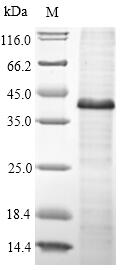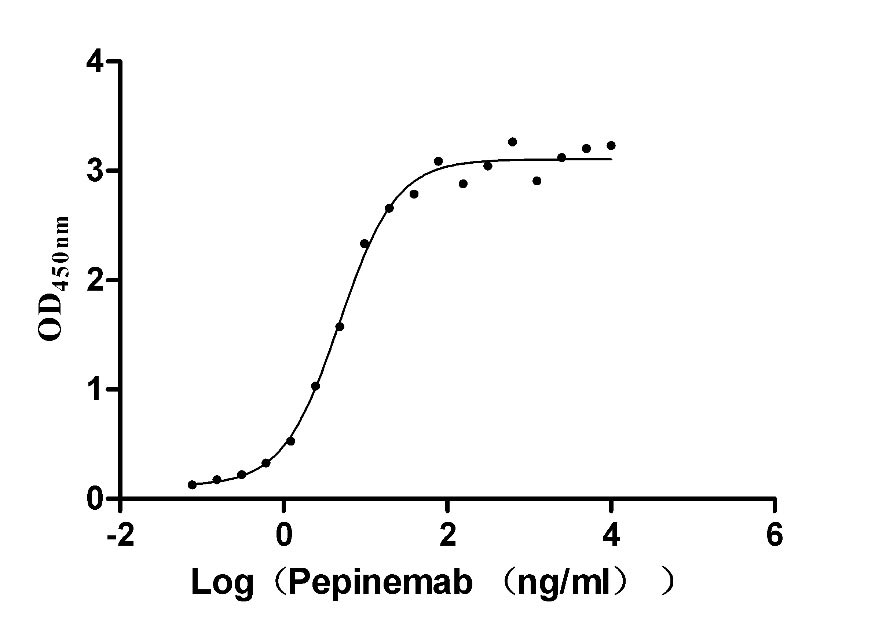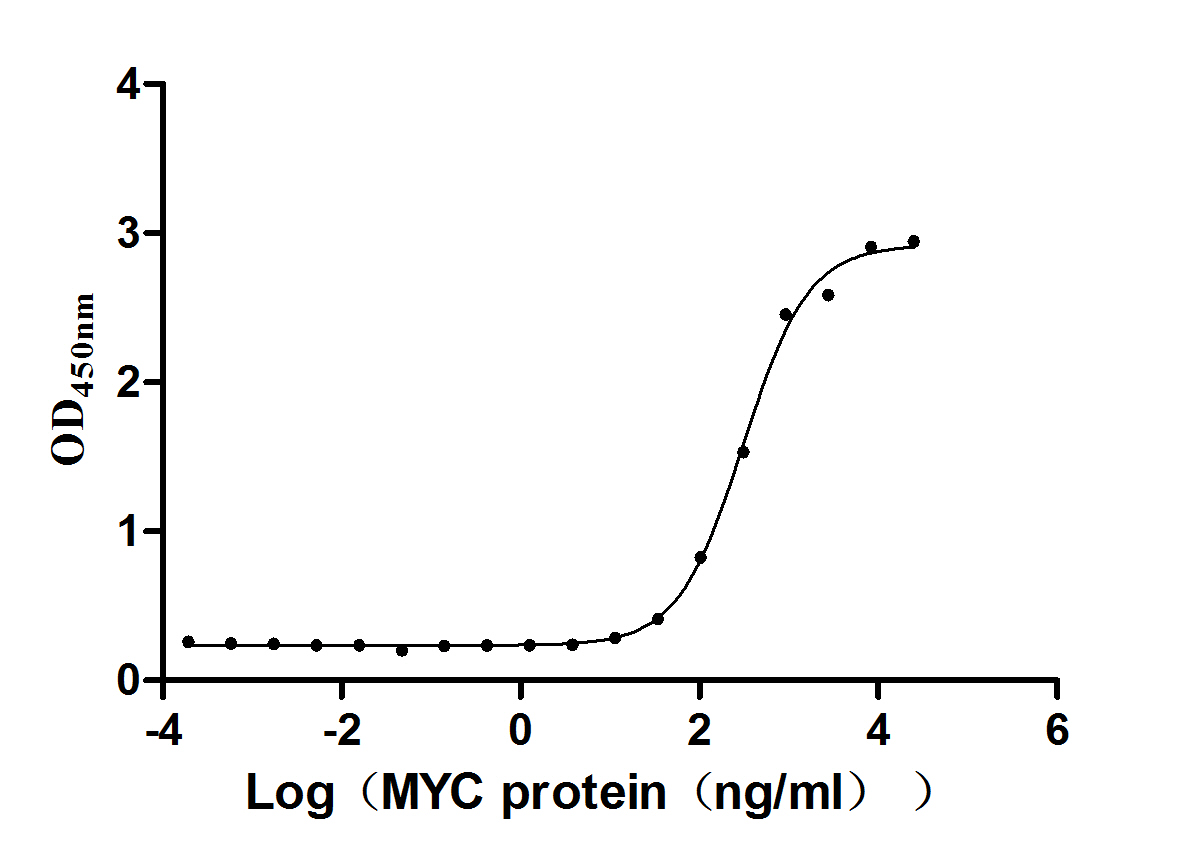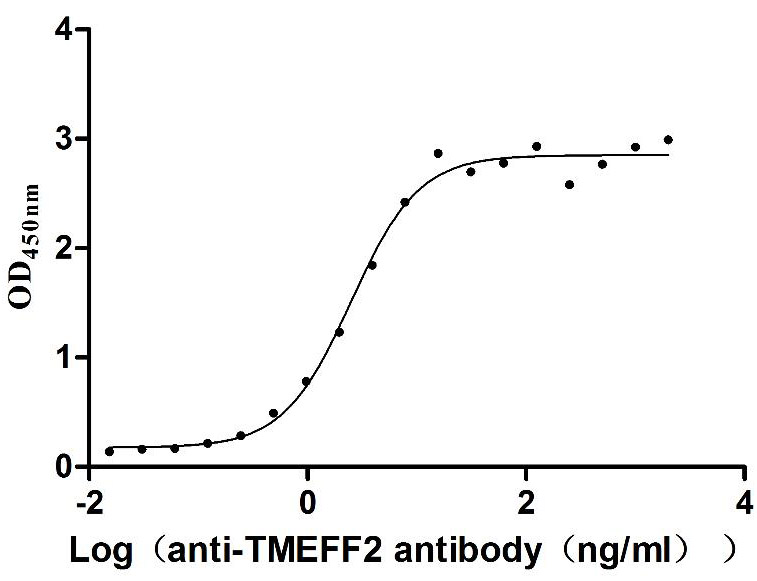Recombinant Human Protein Wnt-5a (WNT5A)
In Stock-
货号:CSB-EP026138HUb1
-
规格:¥1344
-
图片:
-
其他:
产品详情
-
纯度:Greater than 90% as determined by SDS-PAGE.
-
基因名:
-
Uniprot No.:
-
别名:hWNT 5A; hWNT5A; Protein Wnt 5a; Protein Wnt-5a; Protein Wnt5a; Wingless type MMTV integration site family member 5A; Wnt 5a; WNT 5A protein; WNT 5A protein precursor; WNT5A; WNT5A protein precursor; WNT5A_HUMAN
-
种属:Homo sapiens (Human)
-
蛋白长度:Full Length of Mature Protein
-
来源:E.coli
-
分子量:40.8kDa
-
表达区域:62-380aa
-
氨基酸序列IIGAQPLCSQLAGLSQGQKKLCHLYQDHMQYIGEGAKTGIKECQYQFRHRRWNCSTVDNTSVFGRVMQIGSRETAFTYAVSAAGVVNAMSRACREGELSTCGCSRAARPKDLPRDWLWGGCGDNIDYGYRFAKEFVDARERERIHAKGSYESARILMNLHNNEAGRRTVYNLADVACKCHGVSGSCSLKTCWLQLADFRKVGDALKEKYDSAAAMRLNSRGKLVQVNSRFNSPTTQDLVYIDPSPDYCVRNESTGSLGTQGRLCNKTSEGMDGCELMCCGRGYDQFKTVQTERCHCKFHWCCYVKCKKCTEIVDQFVCK
Note: The complete sequence including tag sequence, target protein sequence and linker sequence could be provided upon request. -
蛋白标签:N-terminal 10xHis-tagged and C-terminal Myc-tagged
-
产品提供形式:Liquid or Lyophilized powder
Note: We will preferentially ship the format that we have in stock, however, if you have any special requirement for the format, please remark your requirement when placing the order, we will prepare according to your demand. -
缓冲液:Tris-based buffer,50% glycerol
-
储存条件:Store at -20°C/-80°C upon receipt, aliquoting is necessary for mutiple use. Avoid repeated freeze-thaw cycles.
-
保质期:The shelf life is related to many factors, storage state, buffer ingredients, storage temperature and the stability of the protein itself.
Generally, the shelf life of liquid form is 6 months at -20°C/-80°C. The shelf life of lyophilized form is 12 months at -20°C/-80°C. -
货期:3-7 business days
-
注意事项:Repeated freezing and thawing is not recommended. Store working aliquots at 4°C for up to one week.
-
产品描述:Wnt-5a蛋白(WNT5A)属于Wnt家族成员,在胚胎发育和成人体内许多细胞类型的发育和分化中起着关键作用。在肿瘤发展和进展中,WNT5A蛋白发挥了重要作用。它不仅参与多种细胞和生理病理过程,而且通过调节几种非典型信号通路作为癌基因或肿瘤抑制因子,从而干扰细胞生长,细胞骨架重塑、迁移和侵袭性。此外,WNT5A蛋白在慢性阻塞性肺病、肺炎、肺肿瘤和肺纤维化等肺相关疾病发生发展过程中也发挥了重要作用。j9九游会登录入口首页生物提供大肠杆菌表达的全长Wnt-5重组蛋白,帮助您进行其在不同疾病中的作用机制的理解,为相关疾病的治疗提供了新的思路和可能性。
-
Datasheet & COA:Please contact us to get it.
相关产品
靶点详情
-
功能:Ligand for members of the frizzled family of seven transmembrane receptors. Can activate or inhibit canonical Wnt signaling, depending on receptor context. In the presence of FZD4, activates beta-catenin signaling. In the presence of ROR2, inhibits the canonical Wnt pathway by promoting beta-catenin degradation through a GSK3-independent pathway which involves down-regulation of beta-catenin-induced reporter gene expression. Suppression of the canonical pathway allows chondrogenesis to occur and inhibits tumor formation. Stimulates cell migration. Decreases proliferation, migration, invasiveness and clonogenicity of carcinoma cells and may act as a tumor suppressor. Mediates motility of melanoma cells. Required during embryogenesis for extension of the primary anterior-posterior axis and for outgrowth of limbs and the genital tubercle. Inhibits type II collagen expression in chondrocytes.
-
基因功能参考文献:
- Impaired Wnt5a signaling is associated with poor placentation and subsequent development of preeclampsia. PMID: 30177057
- Decreased hepatic Wnt5a signaling is associated with hepatocellular carcinoma progression and poor prognosis. PMID: 29709351
- Annotation of rs11918967 in WNT5A in tissues might be related to obesity. PMID: 28272483
- Wnt5a expression is critical for proliferation of RL and VZ progenitors and Purkinje cell dendritogenesis during early embryonic development resulting in retarded development of cerebellum during postnatal stages. PMID: 28205531
- Study shows that Wnt5a is upregulated in invasive glioblastoma tissues, and demonstrates that it may regulate the invasion of glioblastoma cells, at least in part via the Daam1/RhoA signaling pathway. PMID: 29207169
- The findings suggest that Wnt5a expression may be involved in the inhibition of cell differentiation and the induction of an inflammatory response. PMID: 29286164
- High WNT5A expression is associated with gliomas PMID: 28627699
- Wnt5a promotes epithelial-to-mesenchymal transition and metastasis in non-small-cell lung cancer, which is involved in the activation of beta-catenin-dependent canonical Wnt signaling. PMID: 29054966
- This study suggests that methylation of Wnt pathway genes, in addition to known CpG island methylator phenotype markers, may help predict treatment outcome and survival in patients with CRC[colorectal cancer. PMID: 29869456
- non-canonical Wnt5a signalling could play a role in early human trophoblast development by promoting cell proliferation and survival. PMID: 27311852
- These findings suggest that WNT-5A modulates fundamental mechanisms that affect airway smooth muscle contraction and thus may be of relevance for airway hyperresponsiveness in asthma. PMID: 27468699
- We performed immunohistochemistry for Ki67, p16INK4a, and WNT5A in human HPs ( hyperplastic polyps), sessile serrated adenomas/polyps (SSA/Ps), and traditional serrated adenomas (TSAs) .The distribution of Ki67 and p16INK4a positive cells in TSAs was different from that in HPs and SSA/Ps. PMID: 28627675
- Wnt5a-Ror2 signaling enhanced tongue SCC cell aggressiveness and promoted production of MMP-2 following DeltaNp63beta-mediated EMT PMID: 28559016
- Here, the s define WNT5A, a non-canonical Wnt ligand implicated in epithelial differentiation, repair, and cancer, as a direct transcriptional target that is activated by KLF4 in squamous epithelial cells. PMID: 27184424
- These findings support that Wnt5a-Ror2 signaling plays a role in UC, support the potential use of Wnt5a as a prognostic marker and provide evidence that Wnt5a signaling may be used as an effective molecular target for novel therapeutic tools. PMID: 28427201
- We show that rosiglitazone increases klotho and decreases Wnt5A in tumor cells, reducing the burden of both BRAF inhibitor-sensitive and BRAF inhibitor-resistant tumors in aged, but not young mice. However, when used in combination with PLX4720, tumor burden was reduced in both young and aged mice, even in resistant tumors PMID: 28232477
- Serum Wnt5a is elevated and associated with disease severity in heart failure patients. PMID: 28357477
- In squamous/adenosquamous carcinoma and adenocarcinoma of the gallbladder positive ROR2 or WNT5a expression is generally associated with a poor prognosis. PMID: 28465645
- The Wnt5a and its signaling pathway can regulate fundamental cellular processes, including specification of cell fate, proliferation, and survival. PMID: 28641961
- Results show that PTEN and WNT5A expression are directly repressed by miR-26b which promotes colorectal cancer metastasis. PMID: 29160937
- The relationship between Wnt5a protein expression and histone H4K20me1 was analyzed. Recruitment of H4K20me1 and SET8 to the Wnt5a promoter and coding regions wa investigated. Results demonstrated that the expression levels of Wnt antagonists were generally low in acute myeloid leukemia (AML), but showed differential expression in acute lymphocytic leukemia (ALL). PMID: 28440495
- WNT5A and IL-6 are connected through a positive feedback loop in melanoma cells PMID: 27191257
- this study reveals that 14-3-3zeta plays a critical role in Wnt5a/ROR1 signaling, leading to enhanced CLL migration and proliferation. PMID: 28465528
- these studies indicate HS1 plays an important role in ROR1-dependent Wnt5a-enhanced chemokine-directed leukemia-cell migration. PMID: 28465529
- Study reports that WNT5A bi-directionally regulates epithelial-mesenchymal transition (EMT) in mammary epithelial cells, thereby affecting their migration and invasion. However, the ability of WNT5A to inhibit breast cancer cell migration and invasion is an EMT-independent mechanism that, at least in part, can be explained by decreased CD44 expression. PMID: 27623766
- disruption of trans-spliced noncoding RNA RMST expression in human embryonic stem cells results in the upregulation of WNT5A, epithelial-to-mesenchymal transition, and lineage-specific genes/markers. PMID: 27090862
- Wnt5a suppressed osteoblastic differentiation through Ror2/JNK signaling in periodontal ligament stem cell-like cells. PMID: 28681925
- Genetic blockade of autophagy indicated an unexpected feedback loop whereby knocking down the autophagy factor ATG5 in Wnt5A(high) cells decreased Wnt5A and increased beta-catenin. PMID: 28887323
- Low WNT5A expression is associated with prostate cancer. PMID: 28748258
- WNT5A signaling regulates 15-PGDH expression. PMID: 27522468
- our study showed that, for the first time, different Wnt5a mRNA isoforms play distinct roles in colorectal cancer (CRC) and can be used as novel prognostic markers for CRC in the future. PMID: 28859077
- High WNT5a expression is associated with osteoarthritis. PMID: 28777797
- We conclude that in RS, WNT5A missense mutations have dominant neomorphic effects that interfere with the function of the wild-type protein. PMID: 28662348
- RSPO2 suppresses colorectal cancer metastasis by counteracting the Wnt5a/Fzd7-driven noncanonical Wnt pathway. PMID: 28600110
- High expression of WNT5A is associated with squamous cell lung carcinoma. PMID: 27876017
- Study shows that WNT5A stimulates dimerization of membrane-anchored FZD4 CRDs and oligomerization of full-length FZD4, which requires the integrity of CRD palmitoleoyl-binding residues. These results suggest that FZD receptors may form signalosomes in response to Wnt binding through the CRDs and that the Wnt palmitoleoyl group is important in promoting these interactions. PMID: 28546512
- Taken together with our previous findings, we have replicated our results from the rodent system in a novel human system. We have revealed a unique sequential cascade involving Atg10, Wnt5a, alpha1 integrin, and matrix metalloproteinase-3 in GS/BMP-4-induced differentiation of hiPS cells into odontoblast-like cells at a relatively early stage. PMID: 27639333
- Elevated WNT5A expression in obesity may function as a negative regulator of angiogenesis.NEW & NOTEWORTHY Wingless-related integration site 5a (WNT5A) negatively regulates adipose tissue angiogenesis via VEGF-A165b in human obesity. PMID: 28411232
- Wnt5a as a master regulator of brain invasion, specifically tumor-promoting stem-like characteristics (TPC), and they provide a therapeutic rationale to target it in patients with glioblastoma. PMID: 28011620
- inhibition of WNT-5A in vivo attenuated lung tissue destruction, improved lung function, and restored expression of beta-catenin-driven target genes and alveolar epithelial cell markers in the elastase, as well as in cigarette smoke induced models of COPD. PMID: 27979969
- Wnt5A/Ryk signaling might provide novel therapeutic strategies to prevent capillary leakage in systemic inflammation and septic shock. PMID: 27159116
- Profound vascular insulin resistance in the visceral adipose tissue arterioles of obese subjects was associated with up-regulated WNT5A-JNK signaling and impaired endothelial eNOS activation. PMID: 27688298
- Aberrant activation of WNT pathways in patients with ESRD significantly correlated with vascular calcification. PMID: 27156072
- Wnt5A could be a potential therapeutic target for reducing microvascular leakage and edema formation in Th2 driven inflammatory diseases. PMID: 27214384
- WNT5A and ROR2 are induced by inflammatory mediators through NF-kB and STAT3 transcription factors, and are involved in the migration of human ovarian cancer cell line SKOV-3. PMID: 28536612
- decreased UHRF1 expression is a key initial event in the suppression of DNMT1-mediated DNA methylation and in the consequent induction of senescence via increasing WNT5A expression PMID: 28100769
- TrpC5 causes a robust rise in [Ca2+]i, enhanced Wnt5a expression and nuclear translocation of beta-catenin, leading to reduced differentiation and enhanced cancer cell stemness. PMID: 27895148
- This study describes the localization and functional role of WNT-5A in human and mouse fibrotic livers. Hepatic WNT-5A expression parallels collagen type I expression. In vivo and in vitro, the myofibroblasts were identified as the key hepatic cells producing WNT-5A. WNT-5A is under control of TGF-beta and its activities are primarily profibrotic. PMID: 28057611
- this study shows that Wnt5a promotes differentiation of dendritic cells, but inhibits their maturation PMID: 27641635
- we confirmed the requirement of Wnt5a in the deferoxamine-mediated osteoblast-promoting effects by analyzing the matrix mineralization of Wnt5a-deficient cells. The promoting effect of deferoxamine on matrix mineralization in wild-type cells was completely abolished in Wnt5a(-/-) cells. PMID: 27540134
显示更多
收起更多
-
相关疾病:Robinow syndrome, autosomal dominant 1 (DRS1)
-
亚细胞定位:Secreted, extracellular space, extracellular matrix. Secreted.
-
蛋白家族:Wnt family
-
组织特异性:Expression is increased in differentiated thyroid carcinomas compared to normal thyroid tissue and anaplastic thyroid tumors where expression is low or undetectable. Expression is found in thyrocytes but not in stromal cells (at protein level). Detected i
-
数据库链接:
HGNC: 12784
OMIM: 164975
KEGG: hsa:7474
STRING: 9606.ENSP00000264634
UniGene: Hs.643085
Most popular with customers
-
Recombinant Human Tumor necrosis factor receptor superfamily member 14 (TNFRSF14), partial (Active)
Express system: Mammalian cell
Species: Homo sapiens (Human)
-
Recombinant Human Semaphorin-4D (SEMA4D), partial (Active)
Express system: Mammalian cell
Species: Homo sapiens (Human)
-
Recombinant Human papillomavirus type 16 Protein E7 (E7) (Active)
Express system: E.coli
Species: Human papillomavirus type 16
-
Recombinant Human Prolactin receptor (PRLR), partial (Active)
Express system: Mammalian cell
Species: Homo sapiens (Human)
-
Recombinant Mouse Retinol-binding protein 4 (Rbp4) (Active)
Express system: Mammalian cell
Species: Mus musculus (Mouse)
-
Recombinant Human Cannabinoid receptor 1 (CNR1)-VLPs (Active)
Express system: Mammalian cell
Species: Homo sapiens (Human)
-
Recombinant Human Tomoregulin-2 (TMEFF2), partial (Active)
Express system: Mammalian cell
Species: Homo sapiens (Human)
-
Recombinant Human Tumor-associated calcium signal transducer 2 (TACSTD2), partial (Active)
Express system: Mammalian cell
Species: Homo sapiens (Human)





















